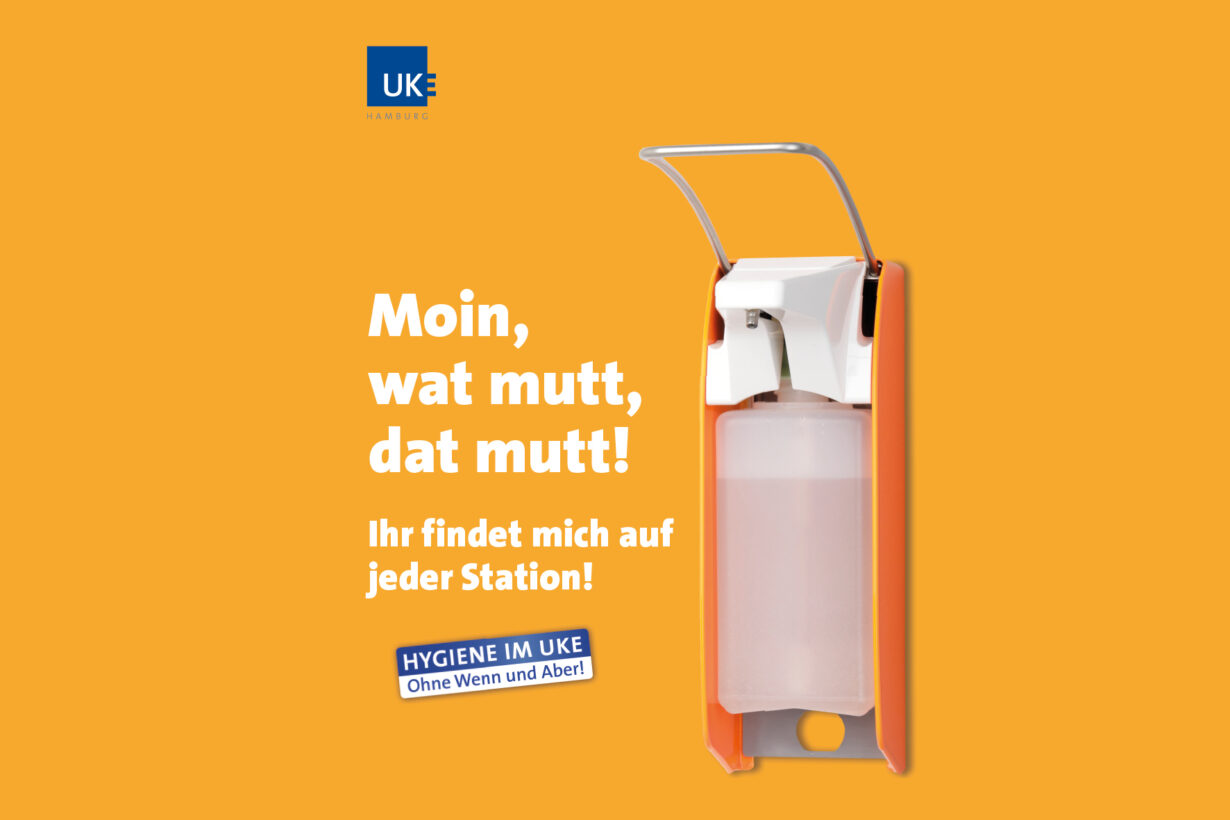
Science has proved the benefits of hand hygiene; however, in clinical routine, compliance with hygiene protocols often lacks. In a 2019 publication, the Geneva-based “Infection Prevention and Control” (IPC) think tank headed by Didier Pittet identifies implementation skills training as the most important element in teaching hygiene practices. But also the behaviour of managers has a great influence on the compliance of employees—which is exactly what Birgit Alpers can confirm from her personal experience at the University Medical Center Hamburg-Eppendorf (UKE). For years, the Deputy Director of Patient and Care Management has been committed to hygiene—with an extensive hygiene campaign and great success.
The workload among physicians, nurses and therapists is high, every additional task consumes time and energy. This is certainly one of the reasons why hand disinfection is so difficult to implement—even with all professionals knowing the benefits. Additionally, both benefit and harm are not immediately visible: things prevented from developing by infection prophylaxis can hardly be taken note of; on the other hand, a wound infection, for example, only develops gradually. And then there are other reasons that can rather be found in behavioural psychology: our implicit and explicit actions do not always fit together. The initial inner plan is suppressed by other things in clinical routine. The German Commission for Hospital Hygiene and Infection Prevention (KRINKO) calls this the “intention-behaviour gap” and therefore calls on those responsible to focus more on psychosocial factors, such as behavioural planning and control when teaching hygiene protocols.
In June 2017 in Geneva, a total of 42 experts, including Professor Didier Pittet , discussed how to improve the implementation of infection prevention and antimicrobial stewardship (AMS) measures. Almost two years later, they published the results of this “Infection Prevention and Control” (IPC) think tank, demanding international organisations, national health authorities and every health facility to make the implementation of infection prevention measures and AMS a priority. Implementation should now be part of every curriculum in health care and IPC career pathways should be created. Guidelines and policies should be coordinated and evidence based.[1] The demands of Pittet and his colleagues always focus on the people. They believe that it is essential to more strongly train and promote personal skills to implement hygiene regulations and scientific knowledge in clinical routine.
[1] https://aricjournal.biomedcentral.com/articles/10.1186/s13756-019-0527-1

Birgit Alpers, Deputy Director for Patient and Care Management at the University Medical Center Hamburg-Eppendorf (UKE) thinks this is exactly the right way to go. “It is the only chance for us to be able to integrate proper hand hygiene into our doctors’, nursing staff’s and therapists’ routine action,” she says. In her opinion, training alone is not enough; instead, skills in dealing with each other are required. “This goes as far as a real hygiene culture,” she explains, giving an example: “Watches, rings and jewellery are now taboo for us during work—and this is a matter of course for all employees.”
According to Pittet and his colleagues, it is above all important how hygiene is communicated, hence attributing a key role to communication. The right hygiene communication (read more about the concept of hygiene communication in this interview ) can therefore help to bridge the gap between intention and action as well as to strengthen compliance and correct behaviour in compliance with hygiene protocols. According to Alpers, a success factor is that the in-house hygiene specialists are on equal footing with doctors, nursing staff and therapists—and are perceived as competent partners. “They must be convinced of and enthusiastic about their cause—and be able to pass that on,” Alpers describes. In her experience, this also entails that hygiene specialists must be backed by the managing board and the centre directors—and that hygiene is made a top priority among all employees and patients. “This only works if hygiene is exemplified by the managers,” says Alpers.
In the UKE, target agreements are an important instrument. For example, targets for hygiene compliance and for the personal hygiene behaviour of staff members were adopted at centre level and are being implemented multi-professionally across all management levels. These goals are thus operationalised down to ward level and include a monetary component for the hierarchical levels in the UKE. Also, in 2016, the first hospital-internal hygiene campaign was initiated to further increase compliance.
In the meantime, the campaign has entered its third round. “The good success is reflected in the growing hygiene culture,” Alpers says enthusiastically. Students, nursing staff, physicians, and therapists, but also patients mainly provide positive feedback. “We now manage to talk openly about hygiene and to support each other in implementing the regulations.” And even if there is criticism: it is important that hygiene has become part of the employees’ daily language. “Of course, this requires competent contact persons and a corresponding organisational structure,” Alpers clarifies.

Based on the campaign’s success, the necessary hygiene measures have been accompanied by an own imagery since the beginning of the pandemic. The visual language ranges from distance markers and large posters to information about how many people can be in rooms or lifts at the same time. The UKE’s Coronavirus Task Force with more than thirty interprofessional managers from all clinic areas meets regularly—daily at the height of the pandemic, even on weekends. The hygiene measures defined here are immediately translated into visuals by corporate communications. The task force with its flat hierarchical structure was and is a success factor in managing the challenges of the pandemic and implementing the multitude of regulations.
The team of the Hospital Hygiene Unit (Arbeitsbereich Krankenhaushygiene, ABKH) consists of physicians, hygiene specialists, nursing staff undergoing further training as hygiene specialists and a joint secretary’s office. The unit is in one central location so that short distances, professional exchange, and joint team meetings are a matter of course. The UKE relies on mentoring systems: as a rule, there are two hygiene mentors in each ward/functional department. In addition to nursing staff, members of all other health professions are also involved in the hygiene mentor training, which comprises a total of forty hours. Lecturers are recruited from both the Hospital Hygiene Unit and from the UKE subsidiaries involved. In addition, there is a two-day advanced training course that clarifies detailed questions about hygiene. Completion of the training is recognised with a certificate and the centre directors personally appoint the hygiene mentors the new task. In clinical routine, the mentors—as part of the team—repeatedly intervene on hygiene, provide information about new developments and are important partners for the hygiene specialists. In addition, there are various meetings, such as the decentralised hygiene commission meetings of the centres and a major annual meeting with expert lectures. “For these meetings, we make sure to have a special location and a nice ambience,” says Alpers, “because we also want to appreciate the work of the mentors and strengthen their awareness of this important topic.”
During the pandemic, it became apparent that this system of hygiene mentors, which has been established over many years, is an important factor in the regulations’ operationalisation. The mentors substantially supported many questions, short training sessions and, of course, the concrete action in daily routine. Likewise, the mentors in the centres were important partners for the hygiene specialists to constantly reassess the dynamic pandemic events and implement individual measures.
The hygiene campaign utilised media such as flyers, posters, screen savers and small gimmicks to draw attention to the issue—over and over and everywhere. With external support, a multi-professional team and corporate communications jointly developed slogans that make people smile, take a closer look, and discuss. “Firstly, it is vital that all employees talk about hygiene and that it is present in daily routine,” explains Alpers. Then, there were information stands, for example on hand disinfectants . “Many colleagues often don’t even know that there are very good moisturising products that provide additional care for the skin,” says Alpers.
According to Alpers, those who want to implement a similar compliance change in their clinic must be aware “that such a cultural change also costs money”. The hygiene campaign, venues of the mentor meetings and information materials should be of high value, as this alone makes the topic appear more attractive. And then: “Hygiene is not the subject of individual appointees but needs many faces and must be lived by the whole team. This is the only way it becomes visible to the outside world,” states Alpers. Example: in every patient room in the UKE, there are coloured dispensers for disinfectants. The campaign “watt mutt datt mutt” (what must be done, must be done) with beautiful pictures of Hamburg and dispensers in neon orange also encourages many visitors to take hand disinfection seriously before visiting their relatives. “This attracts attention—and is well received,” says Alpers.
Already a few years ago, the UKE knew how much hygiene compliance depends on the personal contact with patients and colleagues: in a study , Alpers and her team analysed some activities such as the placement of a peripheral indwelling venous catheter, transferred the individual steps including hand disinfection into a diagram and described the process in a quality management manual. “But it was the personal contact with the colleagues that really changed things, and we were able to clarify many a misunderstanding—for example, that wearing disposable gloves does not replace hand disinfection,” Alpers reports.

In her view, it is equally important to talk about hygiene measures in front of the patients during the individual steps of care. Moreover, she has observed that relatives and friends are often very grateful for information on hand disinfection . “Thus, they learn how they can actively contribute to the protection of the patient and feel less helpless.” However, according to Alpers, patient empowerment has its limits: “Our patients are entitled to professional hygiene—we must not outsource the responsibility to them.” And to ensure professional hygiene, multimodal approaches—such as those called for by the Geneva think tank and implemented by Alpers in clinical routine—are essential building blocks of better compliance.

You can find our hand disinfectants manufactured under GMP conditions at: L+R handdisinfect
Further information on hygiene is available in our L&R Prevent and Protect portal: LINK https://www.hygiene-in-practice.de/
A comprehensive database of pathogens and the respective spectrum of activity required to inactivate them can be found at https://www.hygiene-in-practice.de/pathogene/
Social media channels of the UKE:
Instagram: uke_hamburg | Twitter: @UKEHamburg |
YouTube-Kanal: Universitätsklinikum Hamburg-Eppendorf | UKE – YouTube
LinkedIN: Universitätsklinikum Hamburg Eppendorf | LinkedIn
[1] Zingg, W., Storr, J., Park, B.J. et al. Implementation research for the prevention of antimicrobial resistance and healthcare-associated infections; 2017 Geneva infection prevention and control (IPC)-think tank (part 1). Antimicrob Resist Infect Control 8, 87 (2019)
[1] Kampf G, Reise G, James C, Gittelbauer K, Gosch J, Alpers B. Improving patient safety during insertion of peripheral venous catheters: an observational intervention study. GMS Hyg Infect Control. 2013 Nov 6;8(2):Doc18
Photos: UKE